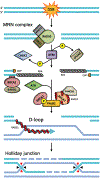Association of Homologous Recombination-DNA Damage Response Gene Mutations with Immune Biomarkers in Gastroesophageal Cancers
- PMID: 34725190
- PMCID: PMC9506445
- DOI: 10.1158/1535-7163.MCT-20-0879
Association of Homologous Recombination-DNA Damage Response Gene Mutations with Immune Biomarkers in Gastroesophageal Cancers
Abstract
The prevalence of homologous recombination-DNA damage response (HR-DDR) genetic alterations is of therapeutic interest in gastroesophageal cancers. This study is a comprehensive assessment of HR-DDR mutation prevalence across gastroesophageal adenocarcinomas and squamous cell carcinomas. Here we investigate the association of HR-DDR mutations with known predictors for immune-checkpoint inhibition [deficiency in mismatch-repair (dMMRP), tumor mutational burden (TMB), and programmed death ligand 1 (PD-L1)]. We confirmed HR-DDR mutations are present in a subset of gastroesophageal adenocarcinomas (23%) and gastroesophageal squamous cell carcinomas (20%). Biomarker expression of dMMRP (18% vs. 1%) and TMB-high with a cutoff of ≥10 mt/MB (27% vs. 9%) was significantly more prevalent in the DDR-mutated cohort compared with the non-DDR-mutated cohort. Mean combined positive score for PD-L1 in the total adenocarcinoma cohort was significantly higher in the DDR-mutated cohort compared with the non-DDR-mutated cohort (10.1 vs. 5.8). We demonstrated that alterations in ARID1A, BRCA2, PTEN, and ATM are correlated with dMMRP, TMB-high, and increased PD-L1 expression in gastroesophageal adenocarcinomas. Our findings show that a subset of gastroesophageal tumors harbor HR-DDR mutations correlated with established immune biomarkers. By better understanding the relationship between HR-DDR mutations and immune biomarkers, we may be able to develop better immunotherapy combination strategies to target these tumors.
©2021 American Association for Cancer Research.
Figures






References
-
- Moschetta M, George A, Kaye SB, Banerjee S. BRCA somatic mutations and epigenetic BRCA modifications in serous ovarian cancer. Ann Oncol 2016;27:1449–55. - PubMed
Publication types
MeSH terms
Substances
Grants and funding
LinkOut - more resources
Full Text Sources
Medical
Research Materials
Miscellaneous

